That Corner Shop: Hydra
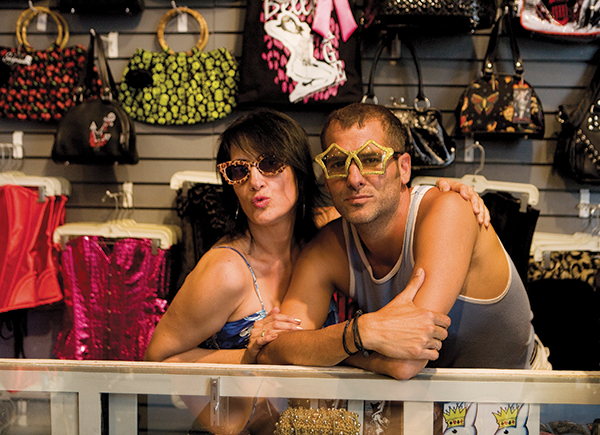
photo by Krysta Jabczenski
Eighteen years at the corner of Congress Street and 6th Avenue, the biggest change yet came to the avant-garde fashion shop Hydra this summer.
A new face joined owner Margo Susco’s one-woman show at her “store with the windows” – new maybe to Hydra clientele but a lifetime companion and best friend to Susco.
Her brother, Joey Susco, just returned to Tucson after 11 years in Rome, where he launched a sister Hydra II (ee-drah dué in Italian) store.
They have stunningly similar retail sensibilities, as if they were the brother and sister and best friends that they really are. Yet they are contrasting characters.
Margo had put up streetcar protest signs in her windows earlier in the year. Joey suggested she take them down when he came on board in August.
“I’m likeable but have an intensity that he doesn’t have,” Margo said.
Joey Susco brings a more mellow demeanor to Hydra.
“I’m back with a lot of new energy and ideas,” Joey said. “I’m updating the look, the racks, the merchandising. We’re getting a lot more Europeans lines. We’re bringing in vintage from the 50s, 60s and 70s.”
Joey replaced some of Margo’s slot wall displays with black grid walls. He got rid of the small wall behind which the shoe section was tucked away. Now the store is wide open. New spot lighting is in place. Soon black marble tile flooring will be installed in front of the jewelry showcases.
“I let Joey loose. I just say ‘Wow!’” Margo said.
The colors – inside and out – are Margo’s touches. She just adorned the interior with an upper layer of purple and lower layer of periwinkle lavender.
Q: You have the boldest exterior color scheme of any Downtown merchants. What are the colors?
Margo: “High gloss safety red and high gloss pure black.”
Q: Why such striking colors?
Margo: “I just think they look clean and sharp. It was important to me to get the right look. Part of being professional is making sure everything looks sharp.”
But what type of store is Hydra with its red-and-back color scheme? Most people think sex, fetish, risqué, that kind of store. Margo Susco has yet to shatter the misconception of how she regards her store.
Q: What’s the theme of your store?
Margo: “I like to call it a diverse avant-garde boutique. We have women’s clothing, lingerie. The misconception is we’re a little weird, but I’m more of a high-end clothing boutique. You can be a little more conservative. You can be a little more saucy. We have costumes and dance wear. We have 50s bowling shirts. We have club wear and western wear for guys.”
Yes, there is lingerie and attire with locks and latches, but Hydra is much more mainstream these days.
“I can get you a nice dress to go to a wedding, a nice top to go to the office and the basic black dress.” Joey Susco said. “18 years ago it was more of a fetish store.”
Back then, vinyl fashions was the hot thing in the alternative crowd. And now?
“Vinyl clothing is coming back in style. Corsets are coming back in style. This is for mainstream use now,” Margo marveled.
What Hydra really is, is a store for women, mostly aged 25 to 45 (and increasingly for men, too), who regularly come in and say “I want to look amazing,” “I’m going to a party and I need a fabulous dress” and “I want to step out of the norm and look fabulous.”
“I help them step outside the box. Absolutely,” Margo said.
Hydra late-2012 mixes what Margo Susco has been doing Downtown since Nov. 4, 1994, and what Joey had been doing since 2004 at Hydra II in Rome with his business partner, Luca Orlandi.
The Susco siblings (Kanella Conklin, a third sibling, earlier this year closed her Kanella’s shop on 4th Avenue. The fourth sibling, Nick, is the only one not in retail) were both born and grew up in Tucson and both moved away in their early adult years. Margo was gone for eight years before returning and opening Hydra.
Joey first went away to Los Angeles for five years and worked at Armani and Guess before embarking to Italy in 2001.
“I’m half Italian. I been to Rome a couple times before. I basically moved there as a foreigner,” he said. “I started working at a retail store. I didn’t speak Italian but a lot of customers were tourists.”
Joey also taught English and was assistant to a photographer.
“Meanwhile, I was just keeping my ears and eyes open,” he continued. “They didn’t have much of a selection or choice. You do have a lot of Goth kids and glam rocker kids but there was nothing there for them. So I decided to open a shop.”
Hydra II was similar to Tucson’s Hydra, but Joey Susco carried more European fashions, and he also had a lot of vintage cowboy boots and western wear, which were hugely popular, especially among tourists from American, Germany – and Texas.
“I was working with so many stylists. It amazed me,” Joey said.
Alas, as successful as Hydra II was, high Italian taxes, the decimated Italian economy and Susco family matters convinced Joey and Luca to sell the shop. Joey returned to Tucson – and Luca Orlandi joined him and is now here, too.
“I had money to invest and I was thinking of America,” Orlandi said. “For me, it’s a change of life. If you have good ideas, it’s easier in America.”
The Suscos are thinking of expanding to Phoenix. Orlandi may operate that store.
Margo said Hydra is so popular in Phoenix that in some Phoenix retail rankings Hydra is listed as the best in Phoenix.
“Joey says ‘I can’t believe the number of Phoenix people that shop here,” Margo said. “There’s already a buzz going on in Phoenix.”
They have been scouting the Phoenix metro for an ideal location for another Hydra store.
“We’re hoping in maybe a year opening something in Phoenix,” Margo said. “We’re keeping our eggs in this basket for now, but we’re doing the legwork.”
Joey’s arrival gives Margo a chance to reduce her hours at the store, really, for the first time since she opened Hydra.
Q: What do you like to do when you’re away from the store?
Margo: “I love being outdoors. Being outside helps me clear my head. I enjoy hiking. I have a 1966 Chevelle Malibu. I love to ballroom dance. I’m happiest listening to Tommy Dorsey and Glenn Miller.”
This article appears courtesy of the Downtown Tucson Partnership

 Prepare to meet, eat and dance yourself silly
Prepare to meet, eat and dance yourself silly Downtown Tucson welcomes an elegant new addition to its already impressive culinary family with the opening of Reilly Craft Pizza & Drink located on the Northeast corner of Pennington and Scott. The historic building that was built in 1906 now boasts lavishly modern décor, a warm atmosphere and some of the best pizza and Italian food in the region. But don’t go into it expecting the same dated menu that you’d find at traditional pizza digs, as Reilly places innovation and execution as the impetus of their vision.
Downtown Tucson welcomes an elegant new addition to its already impressive culinary family with the opening of Reilly Craft Pizza & Drink located on the Northeast corner of Pennington and Scott. The historic building that was built in 1906 now boasts lavishly modern décor, a warm atmosphere and some of the best pizza and Italian food in the region. But don’t go into it expecting the same dated menu that you’d find at traditional pizza digs, as Reilly places innovation and execution as the impetus of their vision. Back when Rory O’Rear began frequenting the Red Room, where bartender Luke Anable poured the drinks that helped Rory develop his appreciation for bartending, Rory mostly drank his spirits straight. Luke and Rory are now head bartenders at Wilko, where they preside over an impressive cocktail list, but back in the day “no one in Tucson did this ‘cocktail stuff’ that’s becoming so prevalent,” Rory explains. The revival of craft cocktails is undoubtedly a good thing, says Rory. However, this new direction in drink mixing is sometimes misunderstood.
Back when Rory O’Rear began frequenting the Red Room, where bartender Luke Anable poured the drinks that helped Rory develop his appreciation for bartending, Rory mostly drank his spirits straight. Luke and Rory are now head bartenders at Wilko, where they preside over an impressive cocktail list, but back in the day “no one in Tucson did this ‘cocktail stuff’ that’s becoming so prevalent,” Rory explains. The revival of craft cocktails is undoubtedly a good thing, says Rory. However, this new direction in drink mixing is sometimes misunderstood. Kidical Mass is a national grassroots movement designed to provide an organized, safe, and fun family bike ride through city streets and it’s back in Tucson by popular demand. On Saturday, October 6th at 10am participants will gather near Himmel Park Library before pedaling over to The University of Arizona, looping around Old Main, and returning to Himmel Park for ice cream and other treats.
Kidical Mass is a national grassroots movement designed to provide an organized, safe, and fun family bike ride through city streets and it’s back in Tucson by popular demand. On Saturday, October 6th at 10am participants will gather near Himmel Park Library before pedaling over to The University of Arizona, looping around Old Main, and returning to Himmel Park for ice cream and other treats.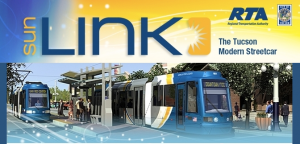 This update is for the week of September 17, 2012: Due to heavy rains that have occurred during the month of August the Sun Link Tucson Streetcar construction team has experienced significant delays to the construction schedule for the entire alignment. The construction team and contractor are working to reevaluate the construction schedule to make up for the delays that the inclement weather has caused.
This update is for the week of September 17, 2012: Due to heavy rains that have occurred during the month of August the Sun Link Tucson Streetcar construction team has experienced significant delays to the construction schedule for the entire alignment. The construction team and contractor are working to reevaluate the construction schedule to make up for the delays that the inclement weather has caused.  Call to artists, designers, sellers of unique items.
Call to artists, designers, sellers of unique items.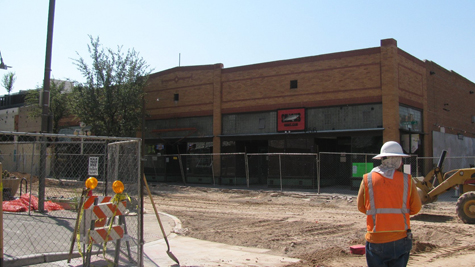 This article is from
This article is from 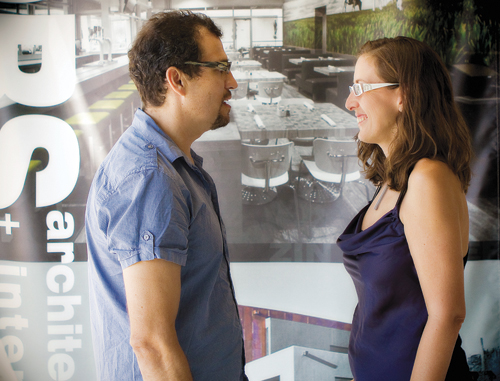 It’s not really about the buildings or furnishings for married architects Miguel Fuentevilla and Sonya Sotinsky. Perhaps you know their names, perhaps you don’t. You do, however, most certainly know their interior designs. They are the design team behind HUB Restaurant & Ice Creamery with its upside-down lamp shades, Playground Lounge and its swings suspended above the bar and marbles ground into the floor, Downtown Kitchen+Cocktails, Borderlands Brewing Co. and the new eatery opening soon at 50 E. Broadway.
It’s not really about the buildings or furnishings for married architects Miguel Fuentevilla and Sonya Sotinsky. Perhaps you know their names, perhaps you don’t. You do, however, most certainly know their interior designs. They are the design team behind HUB Restaurant & Ice Creamery with its upside-down lamp shades, Playground Lounge and its swings suspended above the bar and marbles ground into the floor, Downtown Kitchen+Cocktails, Borderlands Brewing Co. and the new eatery opening soon at 50 E. Broadway.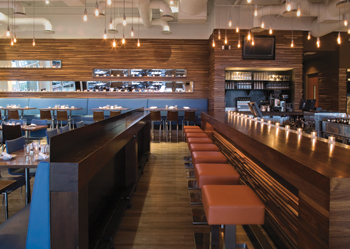
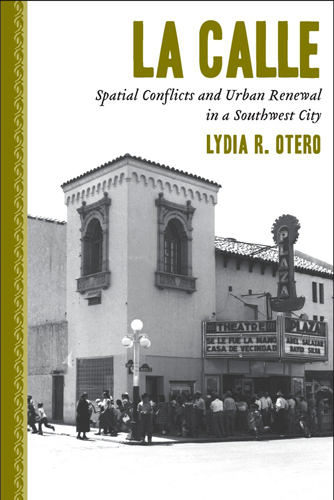
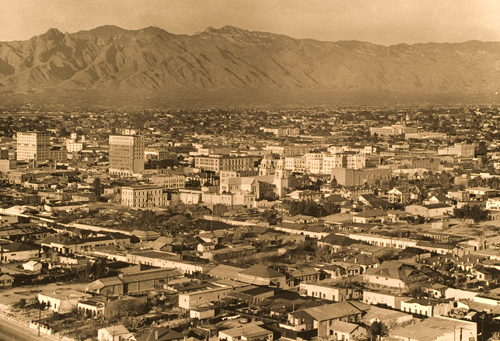




Also find us on...